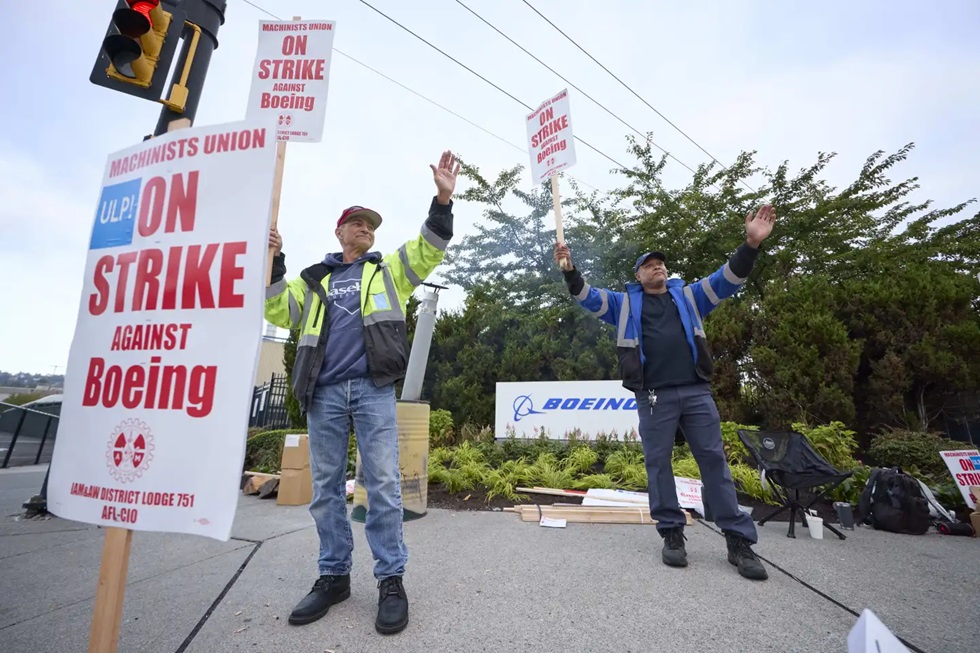
SEATTLE—By an overwhelming ratio of more than 19-to-one, 33,000 Boeing workers, Machinists members in Seattle and the Puget Sound region and in Portland, Ore., voted down a tentative four-year agreement with the big, financially troubled, plane manufacturer. Then, by an even bigger ratio, they voted to strike—a strike which immediately began at 12:01 am on September 13.
Jon Holden, president of IAM District 751 in Seattle, which represents all but 1200 of the workers, reported at 12:45 am Eastern Time on the 13th that 94.6% of workers rejected the contract and 96% voted to strike. A two-thirds vote among 33,000 workers was needed to strike, or the contract would have immediately taken effect. District 24W in Portland represents the 1200 airplane parts workers.
“This is about respect, this is about the past, and this is about fighting for our future,” Holden said. But there was another reason, which top federal safety prober Jennifer Homendy pointed out to Boeing’s new CEO, Kelly Ortberg: “Right now, you have a workforce that doesn’t trust Boeing.”
The Boeing pact is important because the firm is one of the world’s largest civilian aircraft manufacturers, along with Europe’s Airbus.
Many workers told Seattle media that the raise union bargainers recommended didn’t recoup prior losses to inflation. They also protested the elimination of a bonus that was a big add-on to their pay. Workers showed their discontent in the media and with a week of demonstrations and marches, blowing horns and banging pots and pans, in front of Boeing’s Seattle headquarters.
The top complaints were about the contract’s proposed 25% general raise over four years, though raises for some subcategories of workers would be as high as 43.7%. The union sought general raises of 30%-40% over three years. Holden argued the raises were the best they could get and a strike would not produce a better pact. Workers didn’t believe that. Even Holden admitted early in the week—before the votes—that the pact itself would lose. He made no predictions on the strike vote.
The raise was one big feature of the tentative agreement. Another big feature took a major weapon out of Boeing management’s hands: The threat to produce new planes in anti-union South Carolina specifically to avoid hiring and employing union workers in the Puget Sound area.
“This contract isn’t just words on paper. It’s a testament to your collective voice,” said Holden and Portland’s Directing Business Representative, Brandon Bryant. “Every demand, every priority that we brought to the table, carried the weight of your strength. The company knew we were only the conduit for your priorities.” They called it the best contract the union ever negotiated. Workers said it wasn’t.
Banning future moves to South Carolina, during its four-year span, would end what Boeing pulled off under a former chairman who specifically announced plans to build Boeing’s biggest jumbo jets, 787 Dreamliners, in North Charleston, S.C., “to get away from the Machinists.” He succeeded.
Then-Gov. Nikki Haley, R-S.C., and her labor commissioner—a former union-buster—pledged to do everything in their power to keep unions in general and IAM in particular out of the Palmetto State.
Haley called unions “not needed, not wanted, and not welcome” in South Carolina. the least unionized state. That turned out literally to be true: When IAM organizers later came to North Charleston, they faced threats of bodily harm and the union had to withdraw them.
The ban on moving new plane production out of Puget Sound and Portland was another sign of labor’s new militancy. It follows, by less than a year, the contracts the Auto Workers reached with the Detroit automakers through UAW’s rolling “Stand Up” strikes.
Besides rolling back more than 15 years of losses and givebacks, UAW got signed commitments in its pacts that new electric vehicles and their parts would be manufactured in wall-to-wall UAW plants.
But one of the automakers, Stellantis/FiatChrysler, already plans to renege on that commitment at its Belvidere, Ill., plant. The UAW’s contract specifically says the union can strike over such a scheme.
The rejected Boeing pact had stronger job security provisions, lowered the workers’ share of health care costs to 15%, and added employer-paid family leave, the two top bargainers said.
“We secured the next commercial airplane program if launched during the life of the agreement, for our members in Puget Sound and Portland,” they said. They added the new pact assures continued production of the Boeing 737MAX, the 767 Tanker, and the 777X stays in the Puget Sound area.
Boeing is reeling financially and politically. It faces multiple state and federal investigations over recent plane accidents and two fatal crashes overseas. Given those revelations, another important contract provision was “we now have a seat at the table regarding the safety and quality of the production system,” IAM’s contract summary said. The rejected contract would have run through Sept. 7, 2028.
We hope you appreciated this article. At People’s World, we believe news and information should be free and accessible to all, but we need your help. Our journalism is free of corporate influence and paywalls because we are totally reader-supported. Only you, our readers and supporters, make this possible. If you enjoy reading People’s World and the stories we bring you, please support our work by donating or becoming a monthly sustainer today. Thank you!










